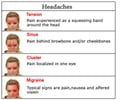The January issue of the American Headache Society (AHS) journal Headache provides an updated assessment of the best treatments to use when a migraine attack begins.

The authors, who are members of the Guidelines Section of AHS, updated the acute migraine treatment guidelines published in 2000 by the American Academy of Neurology (AAN) and the AHS. They used AAN Guidelines Development Procedures to conduct a thorough review of recent scientific literature on this topic. The AHS and AAN also recently published joint guidelines on the prevention of migraine attacks.
"We hope that this assessment of the efficacy of currently available migraine therapies helps patients and their physicians utilize treatments that are the most appropriate for them," said Dr. Silberstein. "Several large, randomized acute pharmacological migraine treatment trials have been conducted since release of the 2000 AAN/AHS guidelines, so it was important that we update our guidelines to reflect the latest evidence."
== Drug classes found to meet "Level A" criteria in the study (established as effective for treating acute migraine) included triptans, dihydroergotamine (DHE), many NSAIDS (nonsteroidal anti-inflammatory drugs), butorphanol nasal spray, and the combination medications sumatriptan/naproxen and acetaminophen/aspirin/caffeine. Several other medications were considered "probably effective" or "possibly effective."
The authors note that clinicians must consider medication efficacy, potential side effects, and possible medication-related adverse events when prescribing acute medications for migraine. Although opioids such as butorphanol, codeine/acetaminophen and tramadol/acetaminophen are probably effective, they are not recommended for regular use.
"This report focusing on acute migraine treatment reflects the changing nature of guidelines toward evidence-based treatment rather than expert opinion," said Dr. Marmura. "Large double-blind, placebo-controlled trials are the basis of determining the effectiveness of acute migraine treatment. Some clinical trials for headache performed prior to publication of the previous guidelines do not meet the more rigorous standards for clinical trials today."
Advertisement
The researchers conducted a systematic review of clinical trials on the efficacy of acute migraine treatments vs. placebo, published in medical journals between 1998 and 2013. Two study authors reviewed each research abstract identified in a formal literature search, and determined whether the full manuscript qualified for review.
Advertisement
Based on these ratings, each class of drugs was deemed effective (Level A), probably effective (Level B), possibly effective (Level C), or judged to have inadequate or conflicting evidence to support or refute the medications' use (Level U). The determination of each efficacy level was also based on the rigor and quantity of published studies on the drug class: to be in Level A, for example, a class of drugs must have been supported by at least two "Class I" studies well-designed, double-blind, randomized, placebo-controlled clinical trials.
The authors note that, based on this assessment, the AHS Guidelines Committee is developing and will publish a companion piece that will help translate these evidence-based guidelines to clinical practice.
This study was funded by the American Headache Society.
Source-Newswise












